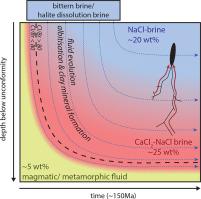Chemical Geology ( IF 3.6 ) Pub Date : 2021-04-24 , DOI: 10.1016/j.chemgeo.2021.120260 Manuel Scharrer , Rebekka Reich , Tobias Fusswinkel , Benjamin F. Walter , Gregor Markl

|
The main ore stage of three similar unconformity-related vein systems in the Schwarzwald, SW Germany spanning a period of activity of ~150 Ma, was investigated to understand the details of fluid penetration from overlying sediments/marine environment into the basement, their evolution as well as the processes involved in vein formation. To investigate temporal and spatial variations of the hydrothermal fluids responsible for mineralization, over 1650 fluid inclusions were analyzed by microthermometry. Of these, a total of 108 fluid inclusions (mainly in fluorite) were successfully analyzed by LA-ICP-MS. The fluid inclusions reveal a binary mixing trend between a CaCl2- and a NaCl-rich endmember. Independent of major element composition, the fluids are metal-bearing (e.g., up to ~100 mg/kg Ba, Pb, Zn, Ni and up to 10 mg/kg Ag), show high As (up to 1000 mg/kg) and low S (below the detection limit in most analyses). Over time, the mixed fluid shows a gradual decrease in CaCl2 and increase in NaCl with slightly decreasing total salinity.
Based on earlier studies and geochemical arguments, the veins formed by anisothermal binary fluid mixing of two fluids, which both were originally derived from seawater and chemically modified through interaction with the basement and sedimentary rocks in different ways. This produced a gradual stratified basement fluid reservoir comprising a modified bittern/halite dissolution brine. The fluids involved in the vein formation are sourced from different depths of this modified bittern/halite dissolution basement brine reservoir: fluid A, a CaCl2-dominated, KCl-poor, deeper seated brine with a salinity of ~25 wt% CaCl2 + NaCl, and fluid B, an NaCl-dominated and KCl-richer brine situated at shallower depths in the crystalline basement with salinities of ~22 wt% NaCl+CaCl2. Based on the Na-Ca-K and Na K thermometers and on Rb/Cs systematics, fluid A records alteration of the Na-, K- and Ca-bearing feldspars of the host rocks; progressive alteration led to consumption of mainly Ca-rich plagioclase in contact with these basement brines. Accordingly, fluid B that subsequently entered the basement was only in equilibrium with alkali feldspars and clay minerals. This scenario produced a gradual change of fluid composition with depth that was pushed to greater depth over time.
K thermometers and on Rb/Cs systematics, fluid A records alteration of the Na-, K- and Ca-bearing feldspars of the host rocks; progressive alteration led to consumption of mainly Ca-rich plagioclase in contact with these basement brines. Accordingly, fluid B that subsequently entered the basement was only in equilibrium with alkali feldspars and clay minerals. This scenario produced a gradual change of fluid composition with depth that was pushed to greater depth over time.
The source temperatures are estimated to ~250 °C while vein formation occurred at 100–170 °C, based on fluid inclusion homogenization temperatures. Thus, significant fluid cooling without abundant fluid mixing (and without major mineralization) must have occurred during fluid ascent (3–7 km, depending on the assumed geothermal gradient). Fluid mixing then resulted in the formation of the major gangue minerals fluorite, quartz, barite and calcite, while the locally confined sulfides must have formed due to an influx of sulfide into the binary mixed fluid. The process of fluid mixing is a rapid and turbulent process. This is recorded by a great diversity of fluid compositions (including ones close to the mixing endmembers) trapped within the same crystal. Compositional variations are even visible within individual fluid inclusion trails.
中文翻译:

地下室含水层的演化和与不整合面有关的热液脉沉积物的形成:来自德国西南部的萤石中单一流体包裹体的LA-ICP-MS分析
对德国西南部施瓦茨瓦尔德的三个相似的与不整合面相关的静脉系统的主要矿床阶段进行了调查,该系统跨越了约150 Ma的活动时间,以了解从上覆的沉积物/海洋环境进入地下的流体渗透的详细信息,以及它们的演化过程。以及涉及静脉形成的过程。为了调查负责矿化作用的热液的时空变化,通过显微热分析法对1650多个流体包裹体进行了分析。其中,通过LA-ICP-MS成功分析了总共108个流体包裹体(主要为萤石)。流体包裹体显示出CaCl 2之间的二元混合趋势-和富含NaCl的最终成员。不受主要元素成分的影响,流体中的金属含量较高(例如,Ba,Pb,Zn,Ni最高至〜100 mg / kg,Ag最高至10 mg / kg),As含量高(最高1000 mg / kg)和低S(在大多数分析中低于检测极限)。随着时间的流逝,混合流体显示出CaCl 2逐渐降低和NaCl升高,总盐度略有降低。
根据早期研究和地球化学论证,由两种流体的等温二元流体混合形成的矿脉,它们最初都是从海水中提取的,并且通过与地下室和沉积岩的相互作用以不同方式进行了化学修饰。这产生了包括分层的卤水/卤石溶解盐水的逐渐分层的地下流体储层。涉及静脉形成的流体来自该改良的卤水/卤石溶解地下盐水储层的不同深度:流体A,一种CaCl 2为主,KCl贫乏的深层盐水,盐度为〜25 wt%CaCl 2 + NaCl和流体B,NaCl为主且KCl含量较高的盐水,位于晶体基底中较浅的深度,盐度为〜22 wt%NaCl + CaCl 2。根据Na-Ca-K和Na  K温度计以及Rb / Cs系统,流体A记录了母岩中Na,K和Ca的长石的变化。进行性改变导致与这些地下盐水接触的主要是富含钙的斜长石酶的消耗。因此,随后进入地下室的流体B仅与碱性长石和粘土矿物保持平衡。这种情况导致流体组成随深度的逐渐变化,随着时间的推移被推向更大的深度。
K温度计以及Rb / Cs系统,流体A记录了母岩中Na,K和Ca的长石的变化。进行性改变导致与这些地下盐水接触的主要是富含钙的斜长石酶的消耗。因此,随后进入地下室的流体B仅与碱性长石和粘土矿物保持平衡。这种情况导致流体组成随深度的逐渐变化,随着时间的推移被推向更大的深度。
根据流体包裹体的均质化温度,源温度估计为〜250°C,而静脉形成发生在100–170°C。因此,在流体上升过程中(3-7 km,取决于假定的地热梯度),必须在没有大量流体混合(并且没有大量矿化)的情况下进行显着的流体冷却。然后,流体混合导致形成了主要的脉石矿物萤石,石英,重晶石和方解石,而由于硫化物流入二元混合流体中,必然形成了局部受限的硫化物。流体混合的过程是快速而湍流的过程。捕获在同一晶体中的大量流体成分(包括靠近混合端元的流体成分)记录了这一点。在各个流体包裹体痕迹中甚至可以看到成分变化。











































 京公网安备 11010802027423号
京公网安备 11010802027423号